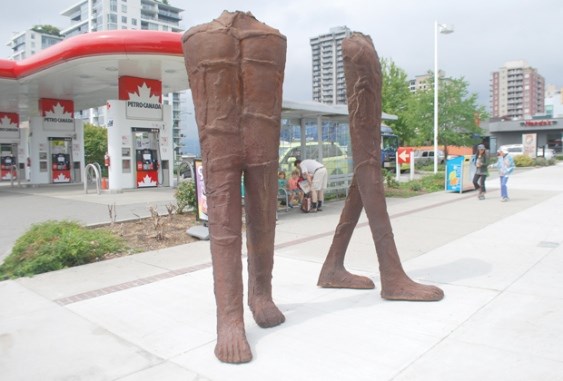This past spring, the Vancouver Biennale expanded its exhibition to North Vancouver with two public art installations along Upper Lonsdale, the headless Walking Figures and Meeting with its crouching red monks, as well as an indoor pavilion of Brazilian art in Shipbuilders Square.
The Biennale art was quick to get the attention of many, including a favorable write-up in the LA Times travel section featuring North Vancouver as an exciting cultural tourism destination. Didn't hurt that the Gordon Smith Gallery also got a mention because of the Biennale sculptures situated in front of it. Closer to home, the Georgia Straight published a positive review of the Brazilian pavilion, and thus began the pilgrimage between the hugely popular OSGEMEOS Giants mural at Granville Island over to North Vancouver via the SeaBus to continue the Biennale experience across the water. Having visitors discover your community and its shops, eateries and other cultural attractions through public art is always a good and lucrative thing.
Media aside, those reading the Mailbox section of the North Shore News will be quick to point out that the spectrum of opinion within the community has been as diverse as the community itself. That's the thing about public art; it gets interpreted through the lens of the people experiencing it, and provides a window on the times in which we live. Love it or hate it, art in public space creates a dialogue through which we learn about ourselves, our neighbours and the world around us. Nothing exemplifies this more than the debate over Walking Figures. The artist, herself a survivor of the Holocaust, is exploring democracy and the sometimes precarious balance between the faceless anonymity of equality and the uniqueness of individualism. Her headless figures have been celebrated and exhibited throughout the world, including a permanent display of 106 in Chicago's Grant Park titled Agora, apropos of the ancient Greek city centre where crowds gathered for commercial and political activity.
The North Vancouver installation of Walking Figures has generated some strong complaints: they frighten our children, we hear enough about beheadings on the news, we want to get away from images of terror. It's an interpretation completely unintended by the artist, but probably a moot point to those calling for their removal. It's hard not to think about the irony of defending this particular installation, while at the same time preparing for the next Biennale installation by Ai Weiwei, one of the most influential artists and human rights activists of our time. He's created a public sculpture best described as a defiant act against censorship in the form of a symbolic obscenity pointed back to his homeland China from the democratic shores of Vancouver. It's a reminder that here, where public art sits on public land governed by public officials, we owe considerable thanks to our mayor and city councillors who, in the course of the daily decisions they make, uphold what we as Canadians value most; our basic human right to freedom of expression.
Walking Figures does indeed go beyond decorative art. It challenges us to transcend our immediate reactions and reflect upon our fears, our stereotypes, our histories and our aspirations. Great public art has proven time and again to be an access point to topics that otherwise make us uneasy to discuss in the public realm and a brilliant catalyst to age appropriate learning in a way that no textbook could ever be. The Vancouver Biennale Big Ideas program is a case in point. With each exhibition, teachers are invited to participate in the award-winning education program that uses art featured in the exhibition as the basis for multi-grade, multi-discipline curriculum, learning resources and artist-led workshops in schools.
Walking Figures and other Biennale artworks have been the inspiration point to thousands of students across nine school districts in their learning and growth into mindful, socially conscious young adults.
Here are a few impressive examples to consider: in North Vancouver, students from Carson Graham secondary and Westview elementary thought Walking Figures created a safe space, offering sanctuary from the effects of bullying. Students responded with their own original art in the form of poems encouraging action against bullying and shared their message during Pink Shirt Day. In Burnaby, students interpreted Walking Figures to be about conformity and peer-pressure. Students learned to practise methods of persuasion and critical thinking. In Richmond, students imagined Walking Figures as a walk in the footsteps of ancestors. They explored what it means to be an individual in a collective on unceded Coast Salish territories and the consequences of attempted assimilation of Indigenous Peoples. The learning continues in 2015 with Artist for Kids Academy of Studio Art planning a BIG IDEAS project inspired by both Meeting and Walking Figures.
The Vancouver Biennale has brought this artwork to North Vancouver as part of the 2014-2016 exhibition. Indeed, we've given you something to talk about.
Miriam Blume is an art and communication consultant and a member of the Vancouver Biennale planning committee.



